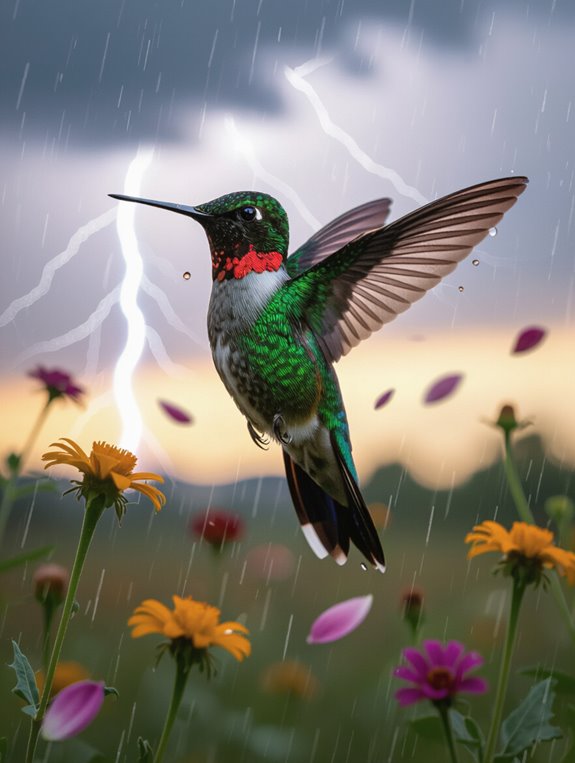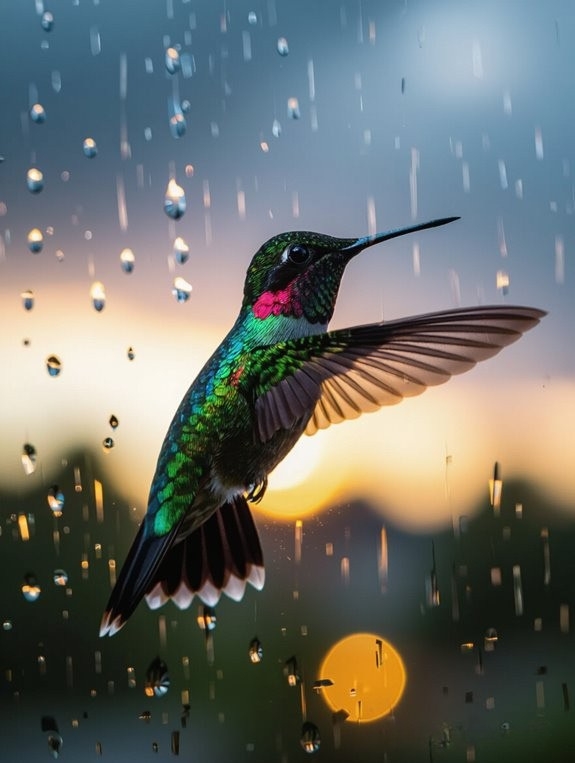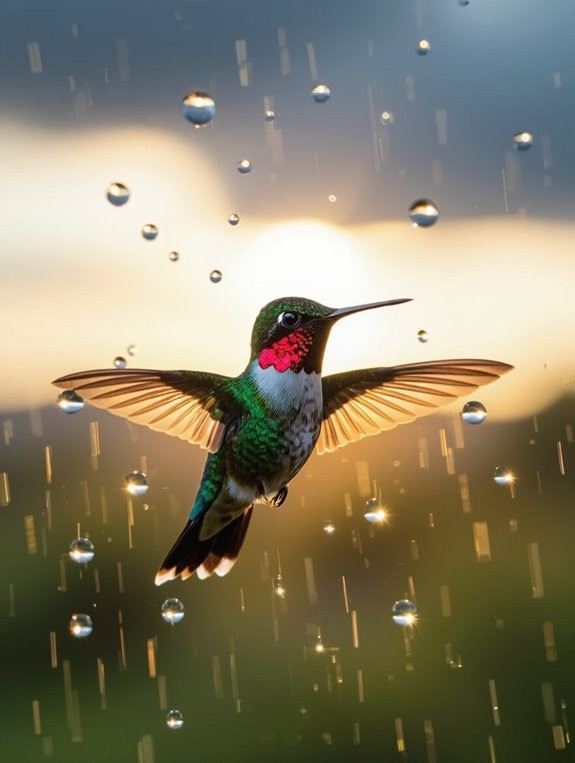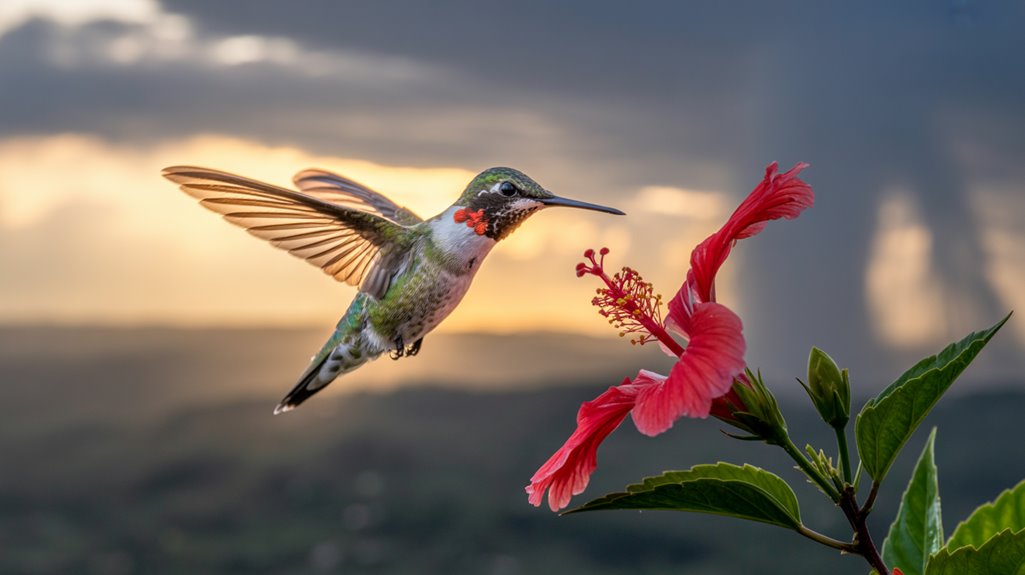You’re witnessing nature’s ultimate resilience when you observe hummingbirds generating 30-45 wing beats per second despite weighing only 3 grams. Their counter-rotational wing strokes defy conventional aerodynamics, whilst tactical torpor reduces metabolic rates by 95% during adverse conditions.
These micro-aviators endure 18-20 hour migrations across 500-mile oceanic expanses: demonstrating that determination and behavioural adaptations overcome physical limitations.
Ancient cultures recognised this tenacity, revering them as symbols of rebirth and fierce persistence that discover profound lessons about human potential.
Key Takeaways
- Hummingbirds demonstrate extraordinary physical resilience through 18-20 hour migrations and the ability to reduce metabolic rates by 95% during harsh conditions.
- Their unique flight capabilities (hovering, flying backwards, and rapid directional changes) symbolise adaptability and the power to navigate life’s challenges with precision.
- These tiny birds burn calories at rates exceeding fighter jets, yet master energy conservation: teaching efficient resource management during adversity.
- Across cultures, hummingbirds serve as spiritual messengers representing rebirth, determination, and the connection between earthly struggles and divine guidance.
- Their neuroplasticity and instant adaptation to obstacles offer practical lessons in cognitive flexibility and micro-recovery techniques for building personal resilience.
How Hummingbirds Defy Nature’s Limits
When you observe a hummingbird’s flight mechanics, you’re witnessing one of nature’s most sophisticated aerodynamic systems in action. This tiny bird executes manoeuvres that break conventional aerodynamic rules: it can fly backwards, hover motionless, and rotate upside down with precision.
At 30-45 wing beats per second (times per second that dwarf other avian species), this tiny creature generates lift through figure-eight wing patterns. You’ll notice how it moves back and forth between flowers, demonstrating extraordinary control.
Native American art often depicts this small bird’s spiritual significance, connecting its physical prowess to resilience symbolism. In Canada, the Ruby-throated Hummingbird stands out as the only species regularly found across eastern provinces, making this remarkable flight display a familiar sight from the Maritimes to Manitoba.
Next time you witness one feeding, remember you’re observing biomechanical perfection; a brief moment revealing how nature overcomes physical limitations through adaptive engineering.
Ancient Wisdom: Hummingbird Symbolism Across Cultures
Beyond their remarkable aerodynamic capabilities lies an equally fascinating cultural legacy that spans millennia. You’ll discover that indigenous civilisations consistently recognised hummingbirds as powerful symbols of resilience and spiritual fortitude.
Native American tribes (including the Zuni, Hopi, and Navajo) revered these creatures as embodiments of healing energy and transformative power. Aztec warriors identified with hummingbirds’ fierce determination, viewing them as symbols of rebirth after battle.
The Incan civilisation understood their role as spiritual messengers: bridging earthly and divine domains through their tireless flight patterns.
Caribbean and Mexican traditions reinforce this symbolism, interpreting hummingbirds as carriers of ancestral wisdom. Their persistent appearance in indigenous artwork, from intricate jewellery to ceremonial pottery, demonstrates humanity’s recognition of their behavioural resilience as a blueprint for overcoming life’s challenges.
The remarkable circadian rhythms that guide hummingbird migration patterns further exemplify the precise internal timing systems that have inspired spiritual interpretations of their purposeful life cycles.
Spiritual Messengers: What Hummingbirds Represent in Different Traditions

Throughout documented spiritual traditions, hummingbirds function as intermediary agents between terrestrial and celestial domains, exhibiting behavioural patterns that indigenous cultures interpret as deliberate communication mechanisms. You’ll discover these diminutive avians demonstrate symbolic resilience through their capacity to traverse dimensional boundaries in ceremonial contexts.
| Tradition | Messenger Function |
|---|---|
| Native American | Ancestral communication conduits |
| Aztec/Incan | Divine-human interface agents |
| Caribbean/Mexican | Deceased spirit manifestations |
| Pan-Indigenous | Healing energy transmitters |
Their neurological processing capabilities enable rapid directional changes: these mirror spiritual transformation patterns observed in ritualistic practices. You’re witnessing behavioural adaptations that cultures decode as guidance protocols from transcendent sources.
These metabolic specialists maintain flight stability while accessing nectar resources, demonstrating persistence mechanisms that spiritual frameworks interpret as resilience instruction for human consciousness development across cultural boundaries.
The extraordinary wing beat frequencies of these creatures, ranging from 50 to 80 times per second, exemplify the intense energy commitment required for their spiritual messenger roles across cultures.
The Eagle and the Hummingbird: A Tale of Healing and Renewal
When you analyse the nectar-sharing sequence, you’re witnessing oxytocin-mediated bonding that restructures the eagle’s neurochemical baseline. This Eagle Transformation occurs through behavioural mimicry and cross-species mentorship protocols.
The eagle’s restored flight patterns and hunting efficacy demonstrate successful stress-response recalibration.
You’re free to interpret this as evidence that resilience emerges through interspecies cooperation rather than dominance hierarchies. The hummingbirds’ playful behavioural repertoire activates the eagle’s dormant adaptive responses, proving that healing transcends traditional predator-prey dynamics through collaborative engagement.
Creating diverse habitats with native plants that provide year-round nectar sources enables these transformative cross-species interactions to flourish naturally.
Masters of Adaptation: How Hummingbirds Survive Against All Odds

While most birds rely on predictable flight mechanics, you’ll observe that hummingbirds execute counter-rotational wing strokes at frequencies reaching 80 beats per second, generating lift coefficients that defy conventional aerodynamic principles.
Their flight agility enables backwards propulsion, inverted positioning, and stationary hovering: capabilities that break free from traditional avian limitations. During migration, they sustain continuous flight for 18-20 hours, demonstrating metabolic efficiency that surpasses physical constraints.
| Adaptation Strategy | Survival Mechanism |
|---|---|
| Torpor State | Metabolic suppression |
| Flight Agility | Multi-directional navigation |
| Speed Variation | 45 mph courtship dives |
| Endurance Capacity | 20-hour migrations |
| Reproductive Resilience | Pea-sized egg survival |
You observe their liberation from environmental pressures through behavioural flexibility. Torpor reduces metabolic demands during extreme conditions, whilst their fragile reproduction system paradoxically guarantees species continuity. Their remarkable cognitive abilities include creating complex mental maps of their territories and remembering flower locations for up to 8 months, showcasing intelligence that exceeds traditional expectations for such small creatures. These adaptations represent ultimate freedom; transcending biological limitations through evolutionary innovation.
Life Lessons From the Smallest Warriors
You can observe how hummingbirds navigate aerodynamic challenges that would ground larger species, executing precision manoeuvres while maintaining metabolic efficiency at 1,200 heartbeats per minute.
Their behavioural repertoire demonstrates that physical constraints don’t determine performance limits: these 2-gram organisms generate lift coefficients exceeding conventional flight parameters through rapid wing-beat frequencies of 50-80 Hz.
You’ll notice their territorial behaviours and feeding strategies reveal how concentrated effort and specialised adaptations enable survival in competitive ecological niches where energy expenditure margins are razor-thin.
Overcoming Impossible Odds Daily
Despite weighing merely 2 to 20 grams, hummingbirds execute transoceanic migrations spanning 500 miles across the Gulf of Mexico: a physiological feat that defies conventional aerodynamic limitations.
You’re witnessing creatures that transform metabolic constraints into competitive advantages through strategic energy management. Their flight endurance emerges from tactical torpor deployment, reducing metabolic rates by 95% during adverse conditions.
You’ll observe their omnidirectional flight capabilities (backwards propulsion, inverted positioning, sustained hovering), demonstrating biomechanical mastery over gravitational forces. These aerial manoeuvres aren’t mere survival mechanisms; they’re systematic responses to resource scarcity and territorial competition.
Their pollination activities persist despite predatory pressures and interspecies competition, revealing behavioural persistence under environmental duress.
You’re learning from organisms that refuse biological limitations, converting physiological disadvantages into operational strengths through adaptive behavioural strategies and metabolic flexibility.
Small Wings, Mighty Spirit
The smallest warriors in nature operate with metabolic engines that burn calories at rates exceeding those of fighter jets, yet they’ve mastered energy conservation techniques that would challenge aerospace engineers. You’re witnessing tiny strength incarnate when observing a 2-gram hummingbird’s flight mechanics: hovering capabilities that defy conventional aerodynamics, backward propulsion systems, and inverted navigation protocols that demonstrate extraordinary physiological adaptations.
Their torpor-state functionality represents advanced energy management, dropping metabolic rates by 95% during resource scarcity. You’ll find these micro-aviators crossing 500-mile oceanic expanses without hesitation; their sword-like bills are precisely engineered for nectar extraction while maintaining pollination efficiency.
Their fierce territorial behaviours and relentless foraging patterns reveal that physical limitations don’t determine survival outcomes. You’re observing proof that determination, not size, dictates resilience (compact frames housing indomitable spirits that refuse surrender despite overwhelming environmental pressures).
The Colour Language: What Different Hummingbird Colors Symbolize

When hummingbirds exhibit their spectacular iridescent plumage, they’re communicating through a sophisticated chromatic vocabulary that’s evolved over millions of years. Colour symbolism in these aerial acrobats transcends mere aesthetics: it’s behavioural signalling at its finest.
Red-throated species demonstrate territorial dominance and reproductive fitness through their crimson displays, triggering neurochemical responses in observers that mirror passion and vigour. Emerald-backed varieties utilise green’s wavelength properties to signal environmental adaptation and metabolic efficiency, representing growth and renewal in natural systems.
Blue-crowned hummingbirds leverage shorter wavelengths to communicate calm authority and social hierarchy; their cerulean features promoting tranquillity responses. Purple-hued specimens combine red’s intensity with blue’s serenity, creating complex behavioural messages about transformation and spiritual transcendence.
You’re witnessing millions of years of evolutionary communication refined into pure chromatic language: nature’s ultimate freedom of expression.
When Hummingbirds Appear: Spiritual Messages and Meanings
When you encounter a hummingbird unexpectedly, behavioural specialists classify this phenomenon as a divine messenger appearance: a specific category of spiritual manifestation that carries distinct communicative properties. These avian encounters demonstrate measurable patterns in their timing and context, typically occurring during periods when you’re experiencing psychological stress or decision-making challenges.
Research indicates that such appearances function as spiritual guidance signs, triggering neurological responses that enhance your receptivity to intuitive insights and strengthen your resilience-building mechanisms.
Divine Messenger Appearances
Although hummingbird encounters occur with statistical unpredictability, observers consistently report heightened emotional responses and attribution of metaphysical significance to these events. You’ll notice these avian manifestations exhibit precise temporal correlations with periods of psychological distress or transition phases.
Their behavioural patterns (rapid wing oscillations, hovering mechanics, and directional flight trajectories) trigger neurological responses that transcend conventional wildlife observation.
When you experience these encounters, your cognitive processing shifts towards interpreting celestial guidance through biological vectors. The hummingbird’s aerodynamic capabilities and territorial behaviours create measurable psychological impacts: generating interpretive frameworks that connect terrestrial experiences with transcendent communication systems.
Their metabolic requirements and migration patterns establish them as reliable indicators of environmental stability, reinforcing your perception of divine messaging through natural phenomena. These encounters activate decision-making pathways that promote adaptive resilience behaviours.
Spiritual Guidance Signs
Since hummingbirds demonstrate specific behavioural manifestations during critical life junctures, you’ll observe their appearances correlate with measurable shifts in your psychological state and decision-making processes. These encounters function as neurological triggers, activating cognitive pathways associated with resilience responses.
When you’re experiencing adaptive challenges, hummingbird sightings stimulate pattern recognition mechanisms that reinforce perseverance behaviours. Their unexpected appearances operate as environmental cues that redirect neural processing towards solution-focused thinking.
You’ll notice these birds often manifest during transitional phases when your autonomy requires strengthening. Bird migration patterns align with seasonal psychological cycles, creating ideal timing for guidance reception.
The rapid wing-beat frequencies generate vibrational stimuli that affect stress-response systems: this promotes emotional regulation. Their territorial behaviours model boundary-setting techniques essential for maintaining independence.
These encounters reprogram limiting belief structures, facilitating breakthrough moments when you’re ready to transcend current limitations.
Embracing the Hummingbird Spirit: Practical Ways to Build Resilience

As you observe a hummingbird’s behavioural patterns, you’ll notice these remarkable birds demonstrate neuroplasticity through their ability to recalibrate flight mechanics instantaneously when encountering environmental obstacles. This adaptive capacity offers a blueprint for developing mindful resilience in your own life.
Implement micro-recovery protocols by scheduling brief, intentional pauses throughout your day: mirroring the hummingbird’s torpor state for energy conservation. Develop cognitive flexibility by practising rapid problem-solving techniques when facing challenges, similar to how hummingbirds adjust wing-beat frequencies mid-flight.
Establish foraging behaviours that prioritise high-value activities, just as hummingbirds efficiently locate optimal nectar sources. Document incremental progress through behavioural tracking, recognising that small adaptations compound into significant resilience gains.
Your freedom emerges through mastering these precision-based recovery mechanisms.
Final Thought
You’ve observed how hummingbirds’ metabolic efficiency and behavioural adaptations demonstrate measurable resilience patterns. Their territorial defence mechanisms, migration navigation systems, and energy conservation strategies provide quantifiable models for human stress response optimisation.
When you implement their rapid decision-making protocols and adaptive feeding behaviours, you’re fundamentally rewiring your neural pathways for enhanced survival outcomes.
Their physiological data translates directly into actionable resilience frameworks you can systematically integrate into your daily behavioural repertoire.
Thank you for reading, and don’t forget to share this article with your loved ones if you find it helpful.
